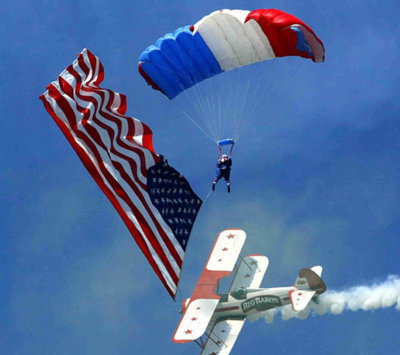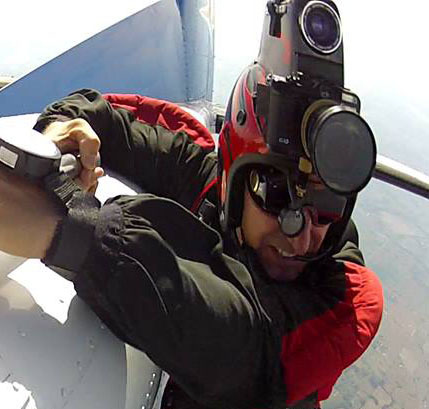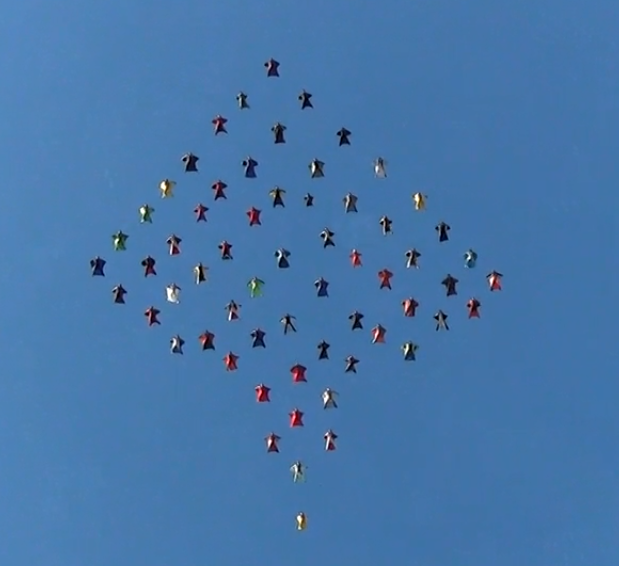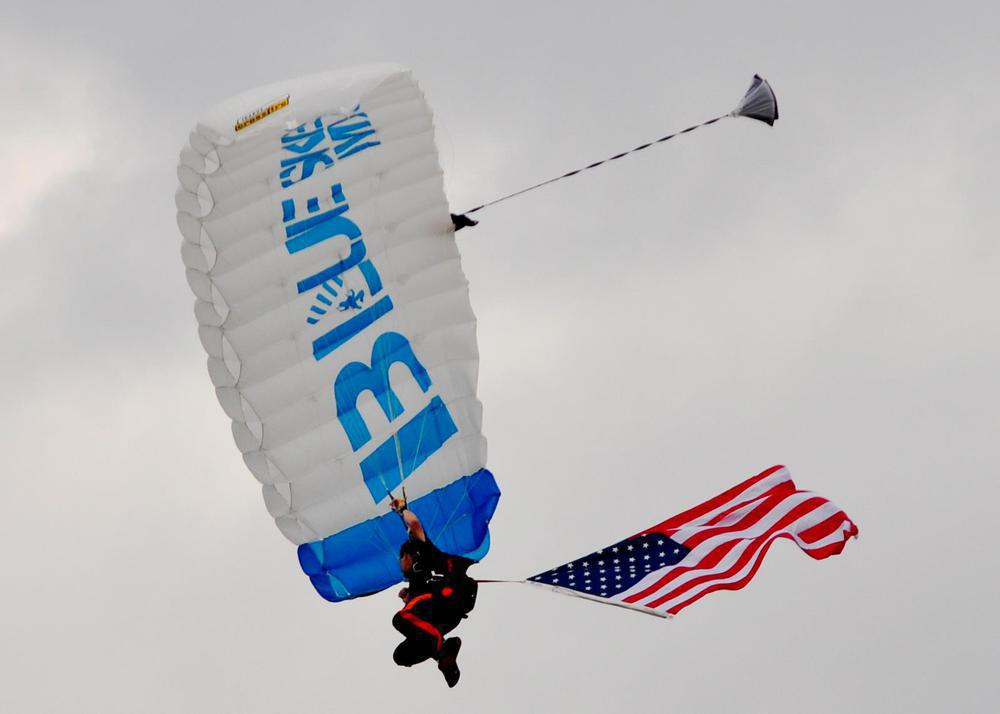Recommended Posts
Ron 10
QuoteRight. You are an AFF instructor who has gone wingsuiting and gotten instruction on it - and you STILL didn't know it was in the SIM. That tells me that your average 500 jump wonder has an even smaller chance of knowing it's there
No, if I was interested in WS I would find the information or find a person to give me the information. You seemed to have missed that I did that.
QuoteUnless someone tells them - which is the point.
The aircraft owner is responsible to make sure that the jumper is informed. The DZO is responsible. If the DZO or the owner does not take that action, then they have to deal with the insurance issues.
The individual jumper is responsible as well.
Creating a rating will not change that.
QuoteAgreed, that's a problem. I do not think the right solution to that is "so therefore let's not teach them anything about separation; the airplane manufacturer will do it. Or someone else will."
So you are going to create an "aircraft separation instructor" program?
Ron 10
QuoteRon you're answering your own question.
No, I am pointing out that creating a rating will not solve any problem.
QuoteYou've been around block, we both know that even though it's never talked about openly for $everal reason$...as skydiving becomes more & more mainstream there's a good sized chunk of participants that in all truth would've been in a bowling shirt 20 years ago.
As you illustrated above, some of 'em even get instructor ratings!
And creating yet another instructor rating will not prevent that.
QuoteNOW more than ever those of us that truly understand there really IS NO reset button here, need to step up and create an environment in which the people wanting on the roller-coaster are tall enough, the safety bar is down and there's nothing within arms reach when on the ride.
YES, the question is how. You seem to think that only by creating another rating system it can work. I think that the wingsuiters could create their own organization, the wingsuiters could create a standard practice and make it available to every DZO, the wingsuiters could create a standard practice and give it to the USPA.
One creates additional BS organization that not even wingsuiters can agree on is the answer. The other gives DZO's, DZM's, jumpers, and aircraft owners the information and lets them decide.
QuoteLast several years we're talking about the 'kids with cameras' - the unprepared & unaware on fast canopies...now the latest & greatest thing is catching on like free porno...I'm sorry, but when you let enough people from the back half of the bell curve play with guns, purposely offering minimum training in the hope they'll figure it out...Well, we're gonna need a lot more body-bags.
Yet I do not see you trying to create a "camera instructor" rating system or a "canopy instructor" rating system. Why is that?
Quote
I don't know why people are so set on creating a system when they have no proof that it will solve the problem, WS people don't even all agree, and MUCH simpler ideas could be tried.
I totally agree with the KISS methodology. However, here’s the problem as I see it.
In the beginning, some “extremely good” wingsuiters emerged. They got extremely good on their own accord. Hell, they had to since there was no-one to teach them. Along the way, we lost quite a few in the learning process. We accepted that.
So, the survivors start to bring on “new” jumpers to the discipline. These new wingsuiters get good at it, but, not “Extremely Good” like their teachers. Now, the “good” jumpers begin teaching newer jumpers who become “OK” at it. In turn, the “OK” jumpers are teaching the 30 jump wonders how to be an expert? This process is broken!
Enter…. Standardized Instruction!!! Maybe not a cure all, but it’s a start. Remember, I’m an Educator and speak to this from an edumacation perspective. This is where “Best Practices” take over.
"Son, only two things fall from the sky."
kallend 2,219
QuoteQuote
I don't know why people are so set on creating a system when they have no proof that it will solve the problem, WS people don't even all agree, and MUCH simpler ideas could be tried.
I totally agree with the KISS methodology. However, here’s the problem as I see it.
In the beginning, some “extremely good” wingsuiters emerged. They got extremely good on their own accord. Hell, they had to since there was no-one to teach them. Along the way, we lost quite a few in the learning process. We accepted that.
So, the survivors start to bring on “new” jumpers to the discipline. These new wingsuiters get good at it, but, not “Extremely Good” like their teachers. Now, the “good” jumpers begin teaching newer jumpers who become “OK” at it. In turn, the “OK” jumpers are teaching the 30 jump wonders how to be an expert? This process is broken!
Enter…. Standardized Instruction!!! Maybe not a cure all, but it’s a start. Remember, I’m an Educator and speak to this from an edumacation perspective. This is where “Best Practices” take over.
Having standardized instruction (which is good) does not imply the need to create a parallel system to AFF, with WS-I, WS-I/E, WS Course Directors, etc. Teaching an already licensed skydiver the issues involved in transitioning to a WS is nothing remotely like teaching a whuffo how to skydive.
The only sure way to survive a canopy collision is not to have one.
normiss 917
How's that working for us?
![]()
kallend 2,219
QuoteHow's that working for us?
Well, no-one has yet been able to answer the question I've asked repeatedly, which is:
HOW MANY WINGSUIT ACCIDENTS CAN BE ATTRIBUTED TO POOR INITIAL TRAINING?
The only sure way to survive a canopy collision is not to have one.
QuoteQuoteQuote
I don't know why people are so set on creating a system when they have no proof that it will solve the problem, WS people don't even all agree, and MUCH simpler ideas could be tried.
I totally agree with the KISS methodology. However, here’s the problem as I see it.
In the beginning, some “extremely good” wingsuiters emerged. They got extremely good on their own accord. Hell, they had to since there was no-one to teach them. Along the way, we lost quite a few in the learning process. We accepted that.
So, the survivors start to bring on “new” jumpers to the discipline. These new wingsuiters get good at it, but, not “Extremely Good” like their teachers. Now, the “good” jumpers begin teaching newer jumpers who become “OK” at it. In turn, the “OK” jumpers are teaching the 30 jump wonders how to be an expert? This process is broken!
Enter…. Standardized Instruction!!! Maybe not a cure all, but it’s a start. Remember, I’m an Educator and speak to this from an edumacation perspective. This is where “Best Practices” take over.
Having standardized instruction (which is good) does not imply the need to create a parallel system to AFF, with WS-I, WS-I/E, WS Course Directors, etc. Teaching an already licensed skydiver the issues involved in transitioning to a WS is nothing remotely like teaching a whuffo how to skydive.
Absolutely agee.... The course might be 5 minutes long. Education is no place for Bureaucracy!
"Son, only two things fall from the sky."
normiss 917
While we may not have hard datum to consider, inserting our heads in our collective asses surely will not improve anything.
With the exception of a few physical appearances anyway.
![]()
billvon 3,173
>the information. You seemed to have missed that I did that.
Right, and that's great.
But you were talking about the lack of specific exit techniques from USPA. And not even you - an instructor who went out of his way to learn about wingsuiting, and actually sought out information on it - knew about it. Given that your average 500 jumps wonder has no chance.
Keep in mind this program is not trying to save someone like you; you're an instructor, have a ton of connections and know how to seek out the instruction you need. The people we do have to reach are the yahoos who have ten pounds of enthusiasm, a pound of experience and an ounce of contacts in the wingsuiting world.
>So you are going to create an "aircraft separation instructor" program?
Nope, we don't need a separate program for that, because we already have one. It's called the ISP. It is taught by instructors or coaches. Exit separation is part of Category F:
==================================
1. Slower-falling jumpers and groups are exposed to upper headwinds longer and are blown farther downwind than faster-falling jumpers and groups.
a. Slower-falling groups should exit before faster-falling groups if jump run is flown into the wind.
b. On days with strong upper headwinds, allow more time between groups on the same pass to get sufficient horizontal separation over the ground.
(1) Provide at least 1,000 feet of ground separation between individuals jumping solo.
(2) Provide at least 1,500 feet of ground separation between small groups, adding more as size of the groups increases.
c. Once the parachute has opened, delay flying up or down the line of flight until—
(1) Any slower-falling group that exited before has opened their parachutes and turned toward the landing area.
(2) The group exiting after has completed their freefall and opened.
2. Flying jump run across the upper winds (crosswind) helps achieve separation between groups.
3. Whether flying one or more aircraft, each pass should allow enough time for jumpers on a previous pass to descend to a safe altitude before dropping jumpers from the next pass.
====================================
billvon 3,173
Agree although it's going to be a bit longer than 5 minutes. The shortest first flight course I ever taught was about 30 minutes, to an AFF-I who had around 3000 jumps.
QuoteQuoteHow's that working for us?
Well, no-one has yet been able to answer the question I've asked repeatedly, which is:
HOW MANY WINGSUIT ACCIDENTS CAN BE ATTRIBUTED TO POOR INITIAL TRAINING?
Depending on your viewpoint either all of them or none of them...same as swooping fatalities.
~ If you choke a Smurf, what color does it turn? ~
QuoteHOW MANY WINGSUIT ACCIDENTS CAN BE ATTRIBUTED TO POOR INITIAL TRAINING?
On the contrary, I could ask you how many jumpers involved in tail strikes recieved adequate initial training, but in the end, neither one of us would be able to answer that question with any degree of certainty.
Arguing the sematics and nit-picking the methods are the old protocol, when time was on our side. The new protocol is much more time sensitive, and much more demanding of results.
The question you should be asking is, 'Could inadequate initial training be a contributing factor in any or all of the tail strikes?'. If the answer is 'yes' then that issue needs to be addressed in the effort to END tail strikes. Ditto for complacency, ditto for lack of placarding, ditto for the failure of the community to make it a 'hot topic' (like harness checks, remmeber when nobody did those?).
Whatever the 'majority' cause may be, or even the 'most likely', the call now is to end tail strikes 100%, so the method must be to address any and all possible contributors to the problem. Excluding any one of them is running the risk that it will lead to the next tail strike, and the possible loss of coverage for aircraft that fly wingsuiters.
QuoteTeaching an already licensed skydiver the issues involved in transitioning to a WS is nothing remotely like teaching a whuffo how to skydive.
Maybe you've only been seeing the dumbed-down WS teaching methods from the poor instructor camps. The FFC's I've been watching are very similar to FJC's. Much time is spent on the ground teaching what can go wrong and how to deal with issues. Students put on gear and practice their entire dives on the ground over and over. Focus of the initial jump is stable freefall and stable deployment at the correct altitude. Wait, am I describing FFC or FJC? It's hard to tell because they're very similar.
QuoteQuoteHow's that working for us?
Well, no-one has yet been able to answer the question I've asked repeatedly, which is:
HOW MANY WINGSUIT ACCIDENTS CAN BE ATTRIBUTED TO POOR INITIAL TRAINING?
John, I know you love wingsuiting and I know you're good at it and don't want to see it be taken out of our sport. You clearly have a passion for this and you, like most, are strong in your convictions and I commend you for that.
I don't have enough knowledge of this discipline to take a side.
However, in my view - the problem which needs to be addressed immediately is from the perspective of the "Risk Underwriter" - the insurance company.
If they perceive that wingsuit jumping is too risky to insure then they will simply remove that risk from the policy i.e. exclusion rider or price that risk so that they can justify the coverage or simply do away with the coverage entirely.
If most non-wingsuiters had their drothers I would venture to say they would vote for the exclusion so that they don't have to pony up more money for a jump ticket.
I hope it doesn't come to that because I don't want wingsuiting to go away.
What I am saying is: now is the time for all sides of this issue to stop bickering and arguing over semantics and instead find some common middle ground and address the concerns of the insurance companies who underwrite the million dollar airplanes from which we jump.
You can always go back and tweak the system.
There are a lot of businesses that have closed their doors because they could no longer afford the insurance premiums.
It's time for cooler heads to prevail.
Someone much smarter than I once said "If not us - who? If not now - when?"
.
kallend 2,219
QuoteQuoteQuoteHow's that working for us?
Well, no-one has yet been able to answer the question I've asked repeatedly, which is:
HOW MANY WINGSUIT ACCIDENTS CAN BE ATTRIBUTED TO POOR INITIAL TRAINING?
John, I know you love wingsuiting and I know you're good at it and don't want to see it be taken out of our sport. You clearly have a passion for this and you, like most, are strong in your convictions and I commend you for that.
I don't have enough knowledge of this discipline to take a side.
However, in my view - the problem which needs to be addressed immediately is from the perspective of the "Risk Underwriter" - the insurance company.
.
We have NO EVIDENCE that poor training caused the problem, and therefore no reason to believe that a USPA WS-I rating will solve the problem. None. It is an assumption with no foundation in fact.
If complacency is the problem leading to tail strikes (and many seem to think that it is) then a reminder notice by the door is more likely to be successful than a whole new USPA training bureacracy.
The only sure way to survive a canopy collision is not to have one.
kallend 2,219
QuoteQuoteQuoteHow's that working for us?
Well, no-one has yet been able to answer the question I've asked repeatedly, which is:
HOW MANY WINGSUIT ACCIDENTS CAN BE ATTRIBUTED TO POOR INITIAL TRAINING?
Depending on your viewpoint either all of them or none of them...same as swooping fatalities.
So the USPA AFF-I rating solved the problem of swooping fatalities? I think you just destroyed your own position.
The only sure way to survive a canopy collision is not to have one.







.thumb.jpg.4bb795e2eaf21b8b300039a5e1ec7f92.jpg)

Ron you're answering your own question.
In one breath you say simple solution, minimum standards.
In the next you show how even with higher standards and requirements ~ ~ ~ the fuck-ups slip through and create a dangerous/hazardous situation.
You've been around block, we both know that even though it's never talked about openly for $everal reason$...as skydiving becomes more & more mainstream there's a good sized chunk of participants that in all truth would've been in a bowling shirt 20 years ago.
As you illustrated above, some of 'em even get instructor ratings!
NOW more than ever those of us that truly understand there really IS NO reset button here, need to step up and create an environment in which the people wanting on the roller-coaster are tall enough, the safety bar is down and there's nothing within arms reach when on the ride.
...'cause sure as shit, a few of 'em don't see the danger and expect Mickey Mouse to take care of them.
We let them in the amusement park, we now have to provide the adult supervision they EXPECT when they bought tickets.
Last several years we're talking about the 'kids with cameras' - the unprepared & unaware on fast canopies...now the latest & greatest thing is catching on like free porno.
A series of actual incidents are looking like a dangerous trend is developing.
There is a glitch somewhere and realistically, anyone who thinks a section in the SIM, some talkin' to, and a sticker by the door with make everything 'all better', needs to take a hard look at all the success that's had previously addressing injuries & fatalities to skydivers off student status performing advanced jumps.
I'm sorry, but when you let enough people from the back half of the bell curve play with guns, purposely offering minimum training in the hope they'll figure it out...Well, we're gonna need a lot more body-bags.
~ If you choke a Smurf, what color does it turn? ~
Share this post
Link to post
Share on other sites